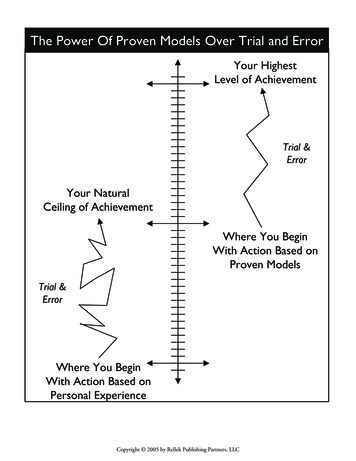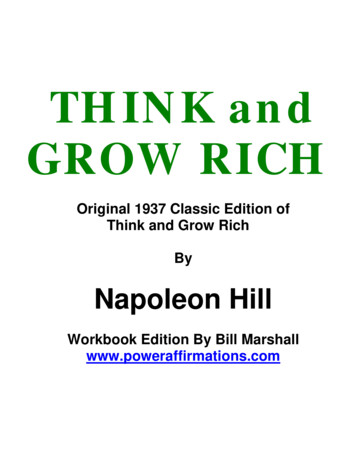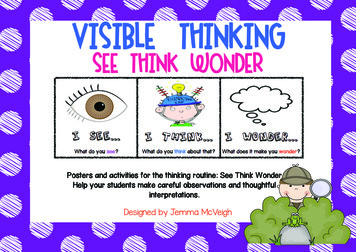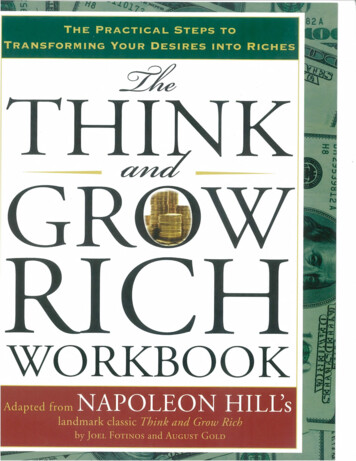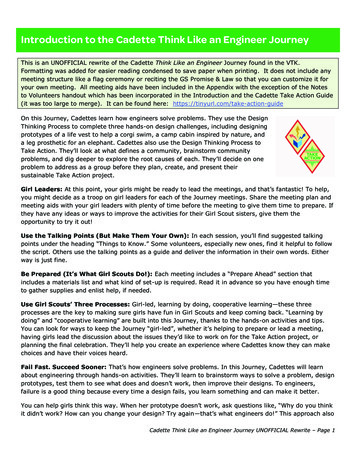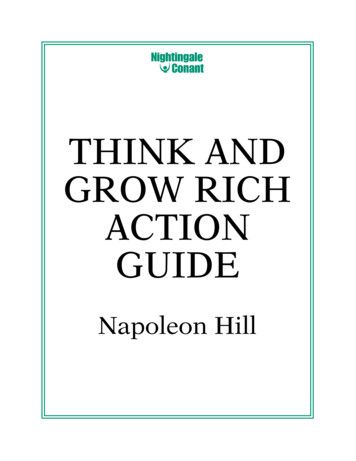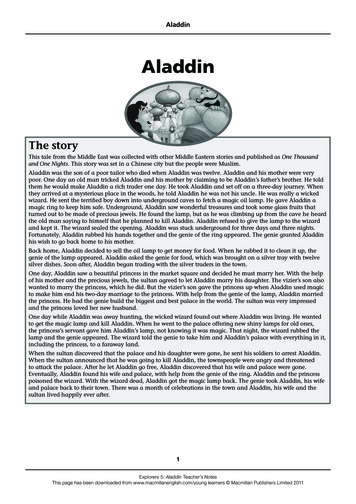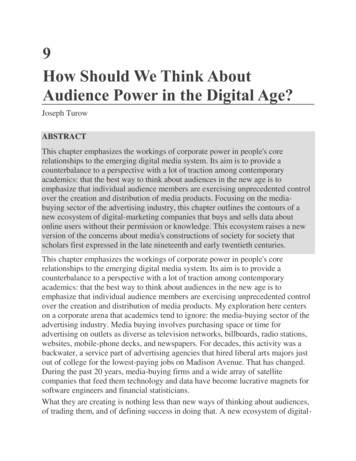
Transcription
9How Should We Think AboutAudience Power in the Digital Age?Joseph TurowABSTRACTThis chapter emphasizes the workings of corporate power in people's corerelationships to the emerging digital media system. Its aim is to provide acounterbalance to a perspective with a lot of traction among contemporaryacademics: that the best way to think about audiences in the new age is toemphasize that individual audience members are exercising unprecedented controlover the creation and distribution of media products. Focusing on the mediabuying sector of the advertising industry, this chapter outlines the contours of anew ecosystem of digital-marketing companies that buys and sells data aboutonline users without their permission or knowledge. This ecosystem raises a newversion of the concerns about media's constructions of society for society thatscholars first expressed in the late nineteenth and early twentieth centuries.This chapter emphasizes the workings of corporate power in people's corerelationships to the emerging digital media system. Its aim is to provide acounterbalance to a perspective with a lot of traction among contemporaryacademics: that the best way to think about audiences in the new age is toemphasize that individual audience members are exercising unprecedented controlover the creation and distribution of media products. My exploration here centerson a corporate arena that academics tend to ignore: the media-buying sector of theadvertising industry. Media buying involves purchasing space or time foradvertising on outlets as diverse as television networks, billboards, radio stations,websites, mobile-phone decks, and newspapers. For decades, this activity was abackwater, a service part of advertising agencies that hired liberal arts majors justout of college for the lowest-paying jobs on Madison Avenue. That has changed.During the past 20 years, media-buying firms and a wide array of satellitecompanies that feed them technology and data have become lucrative magnets forsoftware engineers and financial statisticians.What they are creating is nothing less than new ways of thinking about audiences,of trading them, and of defining success in doing that. A new ecosystem of digital-
marketing companies unknown to online individuals buys and sells data aboutthem – including inferences based on those individuals, own online creations –without their permission or knowledge. Media-buying agencies and theiradvertising clients increasingly apply the information to determine whatcommercial messages individuals should get, what discount coupons they ought toreceive, and what prices they should pay for products and services. Thesurreptitiously constructed market-driven profiles are also central to media firms'increasing competitive need to personalize information, news and entertainment.Built into the logic of these activities is social discrimination across a wideningdigital landscape. The trajectory raises a new version of the concerns about media'sconstructions of society for society that scholars first expressed in the latenineteenth and early twentieth centuries.Media, Audience, and CommunityNicholas Negroponte was at the leading edge of academics who predicted that thepower of the individual will be huge in the digital age. In the 1990s he headed theMassachusetts Institute of Technology's Media Lab, a hothouse for computerbased inventions supported by major corporations. His bestseller Being Digital waspublished in 1995, just a few months after the introduction of Netscape Navigator– the web browser that began to open gates to the Internet for non-techies.Negroponte (1995, p. 5) predicted how communication technologies of the earlytwenty-first century would allow us to become the captains of our own attention, tofocus our interests on what counts for us. “Your telephone won't ringindiscriminately,” he wrote. “It will receive, sort, and perhaps respond to yourincoming calls like a well-trained English butler.”Negroponte seems to have taken it for granted that the creators of the new mediatechnology would tilt it toward the individual's interests rather than toward those ofthe commercial or governmental spheres. It also made sense to him that users ofthe new media technology would revel in that individualism. The idea that, in thetwenty-first century, individuals would hold power over media destinies took hold.An important book to trumpet this idea positively, from economic andlegal standpoints, was Yochai Benkler's The Wealth of Networks. A cover blurb byUniversity of Virginia communication professor Siva Vaidhyanathan accuratelydescribed it as “a lucid, powerful, and optimistic account of a revolution in themaking.” Underscore the word optimistic. As Benkler (2006, p. 2) saw it, thetechnological openness and flexibility of the Internet would allow individualsunprecedented opportunities to collaborate outside of traditional businessframeworks, toward the creation of an astonishing new world. “This newfreedom,” he wrote, “holds great practical promise: as a dimension of individual
freedom; as a platform for better democratic participation; as a medium to foster amore critical and self-reflective culture; and, in an increasingly informationdependent global economy, as a mechanism to achieve improvements in humandevelopment everywhere.”Paralleling Benkler's bold claims for the collaborative efficiencies and individualcreativities afforded by new information platforms were assertions that the newtechnologies provide people with previously unheard of levels of power to followtheir individual interests. Some pointed to the positive potential for that power;others to its negative implications. Cass Sunstein took a dystopic slantin Republic.com and related writings. “The most striking power provided byemerging technologies is the growing power of consumers to ‘filter’ what theysee,” he stated in an often-cited line (Sunstein, 2007, p. 5). To Sunstein, the abilityto customize news sites by topic, to skip unpalatable topics, and to find comfort inideologically similar blogs meant that people can live in idea cocoons either oftheir own making or in the making of which they collaborate with people whoagree with them – a phenomenon that Sunstein called cyber-polarization.Henry Jenkins saw these same individual powers quite differently. In ConvergenceCulture (Jenkins, 2008) and in other works, his focus was on very activecontemporary audiences, which often push media companies to include them intheir activities across multiple platforms, from television to magazines to fanconventions. It was a celebratory view, which reveled in people's growinginfluence on their symbol-making environment. What concerned Jenkins was notideological polarization, but teenagers' cluelessness about what is appropriate whenconfronting the liberating technologies of the digital revolution. “The world hassuddenly developed a printing press for every person on the planet,” he toldSingapore's Straits Times, in response to consternation manifested there about ayoung woman who posted nude photos of herself on her website, “but it has notprepared its culture to be responsible or imagine the consequences of suddenlybecoming media makers” (see Suk-Wai, 2007).Jenkins overreached in his assertion: there surely are places where not everyonehas even the most widespread digital medium, the cell phone – places, in fact,where those who have phones cannot afford to continually charge batteries forthem. His basic point, though, is quite reasonable. Digitaltechnologies are providing more people than ever with the tools for being mediamakers, and so for reaching out to more people than ever. Similarly clear in thenew media landscape is the proposition that individuals are captains of their owninterpretations and increasingly use them as starting points to create culturallyexciting or politically dangerous worlds of understanding, for themselves andothers. Yet his contentions and those of others (for example, those of Shirkey,
2010) about digital powers to the people beg an important question, which theproponents of such views almost never raise: Is the new individual and groupautonomy the central force that will shape the way in which US citizens and otherslearn about the world and realize opportunities to benefit from it? Are other factorsemerging that will be as decisive, or even more so?The basic question is certainly not new with the digital age. Since at least the late1920s, academics have disagreed about the primacy of human agency versus thepower of media industries in shaping people's views of the world. During the firstquarter of the twentieth century many sociologists and political researchers beganto argue for the importance of seeing the media as an institution endowed with thepower to construct society for society. Sociologists John Dewey (1927), RobertPark (1922), and Charles Cooley from the University of Chicago were especiallynoteworthy in emphasizing that the patterned messages that mass-producedperiodicals circulated among millions of people allowed for the creation of a newtype of broadly shared sense of US society even if people were separated by spaceand class. While they tended to write optimistically about ways in which the massmedia could help society maintain an informed democratic public, politicaltheorists were revealing a dark side to the media's community-making capabilities.Academics of the 1920s, 1930s, and 1940s such as Harold Lasswell (1927),Leonard Doob (1935), Alfred McLung Lee (1937), Ralph Casey (1939), andGeorge Seldes (1938) worried that mass media organizations were powerfuldefiners of society's issues and interests in the service of the rich and powerful.They felt that, by letting people know how media firms operate, they could helpcitizens protect themselves from the undue power of those firms to set contentagendas that reflected the needs of marketers and other members of the politicaland economic elite.Beginning in the 1920s, the individual view also gained strong academic attention.Especially noteworthy was a raft of major quantitative studies coordinated by theOhio State University (Charters, 1933) showing that personal backgroundcharacteristics led people to interpret what they heard, saw or read from the mediain their own ways. During the 1930s and 1940s researchers at Columbia University(e.g., Katz & Lazarsfeld, 1955; Lazarsfeld, Berelson, & Gaudet, 1944; Lazarsfeld& Stanton, 1941) and the US military (e.g., Hovland, Lumsdaine, & Sheffield,1949) added evidence to the argument that media have far more limited power tochange people than many in society thought. Quantitative studies that supportedthis “active audience” view also emphasized people's power to choose thegratifications they wanted from whatever media content they selected. In the postWorld War II struggle for mainstream academic space within the communicationfield, the idea of individual autonomy overshadowed the institutional view.
Nevertheless, a new stream of critical communication researchers inflected byMarxist perspectives (for example, Ariel Dorfman and Armand Mattelart, 1975;George Gerbner, 1972; Herbert Schiller, 1969; and Dallas Smythe, 1977) arguedthat individual autonomy actually paled in the face of powerful businessinstitutions. The capitalist system, working with government, they insisted, createdthe broad social and cultural agendas from which audience members had theopportunity to choose their materials.Contrasting academic insights about audience power also converged on qualitativecultural studies. From the 1940s through the 2000s, left-leaning interests inhistorical and textual aspects of popular culture underscored the importance ofunderstanding the industrial production of culture if one is to lay bare the dynamicsof institutional power. One can certainly see this theme in the writings of theFrankfurt School (Theodor Adorno, Leo Lowenthal, and Herbert Marcuse), of theUS mass culture debaters of the 1940s and 1950s (Dwight MacDonald, IrvingHowe, and David Riesman), and of British cultural-studies theorists (RaymondWilliams, Stuart Hall, and David Morley) from the 1940s into the 1980s. (SeeRosenberg & White, 1957, for a classic compendium of readings from theFrankfurt School and from mass culture debates; also see Hall, 1982; Morley,1980; and Williams, 1973). Yet by the 1980s disappointment that powerful cultureproducing systems wouldn't respond to demands for substantial change coincidedwith quite a different analysis: that the actual meaning of a media article, song,sign or video came not from its institutional creation but from its individualreceiver, who could often be seen to create interpretations that resisted authority.One marker of that view was Janet Radway's (1991) description of femalemembers in a romance-novel club. She showed how, in order to fit their ownemotional desires, these women essentially rewrote formulaic stories that, on thesurface, echoed a male-dominated sexual world. Another marker was DickHebdige's (1981) research on British punk, which explored how those whofollowed the lifestyles expropriated different aspects of contemporary taste inclothing and decoration in order to fashion their self-images. The work byNegroponte, Benkler, and even Sunstein fits neatly into this corpus, which acommentator (Chavez, 2009, p. 904) described as indicating the means “by whichconsumers may control commercial meaning.”Scholars with an institutional perspective and an eye on the emerging digital worldhave pushed back against this conclusion. One line of critique, drawing fromcritical political economy, points to the huge corporations that control the contentthat people are supposedly using autonomously in the fragmenting environment.Robert McChesney is a proponent of this view in works such as Rich Media, PoorDemocracy (McChesney, 2000). He finds the key challenges to civic life to be not
in the self-polarizing activities of individuals but in industry consolidations and inoften secretive corporate strategies (enabled by government policies) over the eversplintering media channels. A second stream of writings dives more directly intothe human-agency fray. It sees the liberatory experiences that Jenkins and othershave mentioned actually as a part of the strategies for exploitation. MarkAndrejevic (2007, p. 17) highlights various forms of corporate digital surveillance,in an attempt to counter what he calls “the ongoing attempt to equate new mediatechnologies with the promise of empowerment, individuation, and creativecontrol.” Along related lines, Detlev Zwick, Samuel Bonsu, and Aron Darmody(2008, p. 174) argue, for example, that media executives:have begun to realize the benefit of providing individuals with places for playfulproduction of their own consumption experiences, a fact demonstrated by thepopularity of numerous massively multiplayer online role-playing games(MMOGs), open-source and hacker cultures, and fan communities. [. . .] Alwayson the lookout for new ideas, products, and services to market, managers areseeking ways to appropriate, control, and valorize the creativity of the common.Dovetailing with this view of co-optation are variations on Dallas Smythe's 1950snotion of the audience as worker. Andrejevic (2003, 2007) argues bluntly thatreality shows and user-generated content that sites such as Facebook use to drawadvertising are direct examples of free labor in the interest of corporate profits.Other views try to accommodate both individual interests and corporate power.Tizziana Terranova (2000, p. 33), for example, emphasizes that in blogs,Facebook, YouTube, MySpace, and so many other places in the digital economythe free labor of consumers “is simultaneously voluntarily given and unwaged,enjoyed and exploited.” José Van Dijck (2009, p. 41) pushes this understandingeven further, arguing for “user agency as a complex concept involving not only hiscultural role as a facilitator of civic engagement and participation, but also hiseconomic meaning as a producer, consumer, and data provider, as well as the user'svolatile position in the labour market.”As Van Dijck's formulation points to an important mixture of elements ofindividual autonomy amid corporate control, it implies the possibility of comparingthe two assertions about audience power on the same plane. It's an importantinsight because, despite an ocean of writing about audience power over the pastcentury the viewpoints have typically drawn on virtually separate worlds of mediascholarship for their evidence. The audience-autonomy realm tended to focus onsocial–psychological “effects” research, while the corporate power domain broughtevidence from organizational and industrial practices. What is different about thedigital environment is that both academics celebrating audience power and thoseemphasizing corporate influence over audience members have made their cases on
the basis of the production and distribution of messages. Van Dijck's formulationfalls short, however, in suggesting the relative importance of the individual versusthe institutional position. Certainly, Andrejevic and Terranova make the case forcorporate media power. The scope of their examples may not match the broadscope of autonomy that Negroponte, Benkler, and possibly Jenkins claim forindividuals in the digital arena.The following pages sketch a counterpoint that does have overarchingimplications. The thesis is that new media-buying activities are the fundamentalvehicles through which corporate influences erode individual autonomy in thedigital-media age. None of this denies the spaces for individual and group initiativethat Negroponte, Benkler, Jenkins, Sunstein, and others identify in the newenvironment. The fundamental logic of the emerging media-buying system,though, privileges institutional power. It aims to constrain individuals' everydaymedia contexts, as well as to channel audience choices and initiatives toward thegoals of marketers and of publishers – that is, the creators and distributors ofcontent.The Transformation of Media BuyingAdvertising lies at the core of much of the media, and it is the force that sustainsmuch of the content on the web, including many – if not most – bloggers. At base,advertising involves payment for media attempts to persuade people to purchase orotherwise support a product or service. Most people likely think of advertising interms of its most visible manifestation: the persuasive message. Yet the definitionsuggests two sets of activities in addition to the creation of the ad. One, which ispart of marketing research, entails evaluating whether and how the messageworked. The other, traditionally called media planning and buying, revolvesaround the provision of funds to pay for placement of the notice. Before the 1980s,advertising practitioners considered media buying and planning as ratherstraightforward, unexciting components of a standard (“full-service”) agency'sofferings to clients. During the US broadcast television era (roughly, 1948–1988)the media-buying process became so predictable for national advertisers that manyoutsiders considered buying print space and broadcast time for clients a paint-bynumbers activity. They understood that a large part of the overall agency revenuestypically came from the (then standard) 15% commission garnered from whatclients spent to place their commercial messages. But they also knew that most ofthe work was conducted by low-paid recent college graduates who poured overboring television ratings and periodical circulation data in conjunction withadvertising charges to determine the key measure of an ad vehicle's efficiency:
CPM (cost per mil), the price for reaching 1,000 members of the target audiencevia that outlet.In the 1960s and 1970s media-buying independents (those disconnected fromadvertising agencies) emerged in Europe and North America. The clients of thesefirms were not the blue-chip advertisers that full-service agencies on both sides ofthe pond coveted. Independents tended to attract direct-marketing companies thatcreated their print ads or TV commercials themselves and needed an intermediaryto buy space or time for them. Beginning in the mid-1970s, though, majoradvertisers in the UK began to accept that standalone buying firms sometimes hadmore expertise than buying units of full-service agencies. In 1988, advertisingagency entrepreneurs Maurice and Charles Saatchi bought the dominantindependent buying firm and merged it with the media-buying activities of theirthree UK ad agencies into one standalone subsidiary, Zenith Media, with hugebillings. A major rationale for media-buying agencies of Zenith's size was that itwould help clients face two critical developments efficiently. One was the ongoingfragmentation of electronic media as commercially supported cable, satellite, andradio channels proliferated in Europe, the US, and other parts of the world. A largebuying firm, advocates said, would have the staff and computer facilities toanalyze the best media mix for each client's products in this intimidating newarena. The other development was the growth of huge conglomerates (TimeWarner, Disney-ABC, News Corporation, Viacom-CBS) that owned manyadvertising platforms in different media industries and could potentially raise theprice of time and space. Supporters of large media-buying firms contended thattheir hundreds of millions of dollars from multiple clients could act as acounterweight to the media firms' clout during bargaining over prices andplacements.Zenith marked a focus on standalone media-buying divisions – a focus placed bythe agency-holding companies that were beginning to emerge in the UK, France,and the US. Driving the holding companies' growth was the notion that dominancein all parts of the industry could be achieved by buying a number of full-service adagencies with worldwide networks, great creative boutiques, and allied businessessuch as public relations outfits. The first agency-holding company, Interpublic, wasactually founded in 1960; but the notion did not catch on until the 1980s. The1990s saw enormous struggles for position and control over agency conglomerates,as well as over their media-buying divisions. The four dominant worldwideholding companies that exist today emerged by the early 2000s: Omnicom andInterpublic, based in New York; WPP (originally Wire and Plastic Products Plc.),based in London; and Publicis (which had absorbed the Satchis' holdings), sited inParis. In addition to these were two firms with French pedigree, which held a
particular claim to fame as buying authorities: Aegis, based by then in London; andHavas, based in Suresnes, France. These six were eventually quite successful atdominating the territory. According to a research firm that keeps track of buyingfirm developments, they spent 224 billion advertising dollars worldwide in 2009(RECMA, 2010). That year the six firms controlled about 45% of purchasing in theUS advertising market; in most European countries the share reached 80%(RECMA, 2010).The 2000s marked a period when the major buying firms began, with theirquantitative audience-targeting models, to earnestly exploit the rise of thecommercial Internet as a testing ground for the coming age of ubiquitous digitalmedia. Although advertising “online” appeared during the 1980s on computerdialup services such as Prodigy, the business was marginal and ad agencies didn'tconsider that it had mainstream possibilities. The growth of commercialadvertising on the World Wide Web with the introduction of the Netscape browserin 1994 pointed to a venue for marketers to reach millions of audience members.The second half of the 1990s marked a transition period during which publishersand various partners refined three technologies that would become the basis for theaudience-marketing logic that took flight in the next decade: the banner, theinteractive link, and the cookie.The banner and the advertising-oriented link seem to have emerged together onOctober 26, 1994, when the popular online technology magazine Wired began tosell pictorial banners in large quantities on its new website Hotwired. 1 Soonthereafter Netscape employees Lou Montulli and John Giannadrea revolutionizedadvertising by creating the cookie, a small text file that a website could place on avisitor's computer. They were responding to online retailers complaints that theycouldn't handle customers' multiple purchasing requests (Schwartz, 2001). Everyclick designed to put an item in a virtual shopping cart would appear to the onlinestore as if it were made by a different individual. Consequently, a person would notbe able to buy more than one thing at a time. Montulli and Giannadrea made thecookie with an identification code for the visitor and codes detailing the clicks thatthe person had carried out during the visit. The next time the person's computeraccessed the website, tags on the browser would recognize the cookie. Note thatthe cookie could not by itself distinguish between two separate people using thesame computer. That was the result of Montulli and Giannadrea's decision to havethe cookie work without asking the computer user to accept or contributeinformation to it. There was an ominous downside to that seamless approach: bynot making the computer user's permission a requirement for dropping the cookie,the two programmers were building a lack of openness at the center of theconsumer's digital transactions with marketers.
During the 1990s and into the 2000s, marketing technologists developed othermethods for following individuals through the digital environment. A web beacon(or tracking pixel) is a graphic on a web page or in an email message that oftenactivates a program in order to monitor the activity of visitors – for example, whatthey read and for how long. A Flash cookie (technically, a locally shared object) isa collection of cookie-like data stored as a file in a user's Adobe Flash computersoftware; marketers sometime use it so that the data will not be lost when standardcookies are deleted. The development of the banner ad, the link, the cookie, theweb beacon, and the Flash cookie helped digital divisions of media-buying firmsand their technology partners to refine their digital trade through the 2000s to makeit central to marketers considering advertising online. The essential approach wasto emphasize that the new medium allowed for the quantitative measurability ofaudience activities in ways that would yield a much more accurate understandingof a client's return on investment (ROI) of its ad monies than had been possiblewith analog advertising vehicles such as newspapers, magazines, radio, television,and outdoor boards. Moreover, media buyers contended, it was now possible to gobeyond measuring the responses of panels or samples of audiences, as had been thenorm in the analog world. Now it was possible to note and store the responses ofindividuals via their click-like behaviors – for example, by using the mouse toactivate a link, by moving a mouse to activate tracking pixels on an ad, or bypressing a button to change a channel or to choose a product on a television screen.Initially the emphasis on quantitative measurement served a direct-marketingmodel of advertising. The goal was to provoke a sale or an action that wouldconceivably lead to a sale. The rapid rise of Google search as an advertisingpowerhouse, which began around 2001, was a result of an auction-based pay-perclick (PPC) revenue system that reflected this approach. Google initially carried itsPPC model to the contextual advertising system that it established with sitesthroughout the web and in its Gmail service. In a contextual advertising network,when an advertiser bids for a keyword, the network's computers find a web pagefrom the network's roster of sites that reflects the keyword. On the basis of therelevant context, the network serves the ad. If the visitor to the site clicks on the ad,the advertiser pays the agreed-upon amount and the network shares it with thewebsite. Both in the advertising search and in the contextual advertisingbusinesses, the percentage of visitors who click might be 1% or less. But, withhundreds of millions of visits, Google could still make significant amounts ofmoney with the PPC model.While Google executives extolled this direct-selling approach as the purestexample of web results in action, many web-content providers didn't have anythinglike the numbers of visits enjoyed by a search engine such as Google or by a
“portal” such as Yahoo. These smaller publishers preferred to sell displayadvertising on a “cost per thousand impressions” basis that paralleled the traditionof newspapers, magazines, television, and other analog media. The logic was thatads for companies that sell cars, financial services, and movies may not need toyield a click action to have an impact on a person's image of the product and onfuture purchase decisions. But this forgoing of the direct-click payment model ofadvertising sales didn't mean that media buyers were giving up on their insistencethat the web was a more measurable platform than traditional media. Instead,media buyers and publishers advanced new ideas of how to think of the success ofimage ads that could be measured even as they paid on a CPM basis. Some of thenotions centered on “engagement” – time spent on, or interest in, the page with thead was an indication of the opportunity to see with it. A different way to think ofthe measurability of an image ad's success was to look at whether viewing anadvertisement at one point led to the purchase of a product at another point – eitheron the web or off it. This definition of success – call it the long click – became animportant reason for following individuals' activities across media, and ultimatelyfrom online media to offline retailers such as supermarkets and car dealers
new ecosystem of digital-marketing companies that buys and sells data about . counterbalance to a perspective with a lot of traction among contemporary academics: that the best way to think about audiences in the new age is to . An important book to trumpet this
